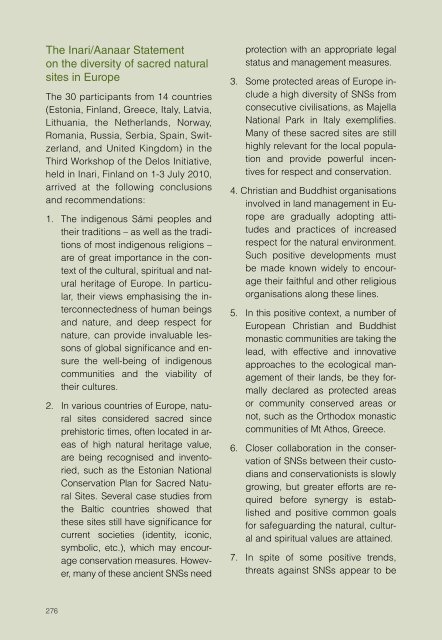The Diversity of Sacred Lands in Europe - IUCN
The Diversity of Sacred Lands in Europe - IUCN
The Diversity of Sacred Lands in Europe - IUCN
Create successful ePaper yourself
Turn your PDF publications into a flip-book with our unique Google optimized e-Paper software.
<strong>The</strong> Inari/Aanaar Statement<br />
on the diversity <strong>of</strong> sacred natural<br />
sites <strong>in</strong> <strong>Europe</strong><br />
<strong>The</strong> 30 participants from 14 countries<br />
(Estonia, F<strong>in</strong>land, Greece, Italy, Latvia,<br />
Lithuania, the Netherlands, Norway,<br />
Romania, Russia, Serbia, Spa<strong>in</strong>, Switzerland,<br />
and United K<strong>in</strong>gdom) <strong>in</strong> the<br />
Third Workshop <strong>of</strong> the Delos Initiative,<br />
held <strong>in</strong> Inari, F<strong>in</strong>land on 1-3 July 2010,<br />
arrived at the follow<strong>in</strong>g conclusions<br />
and recommendations:<br />
1. <strong>The</strong> <strong>in</strong>digenous Sámi peoples and<br />
their traditions – as well as the traditions<br />
<strong>of</strong> most <strong>in</strong>digenous religions –<br />
are <strong>of</strong> great importance <strong>in</strong> the context<br />
<strong>of</strong> the cultural, spiritual and natural<br />
heritage <strong>of</strong> <strong>Europe</strong>. In particular,<br />
their views emphasis<strong>in</strong>g the <strong>in</strong>terconnectedness<br />
<strong>of</strong> human be<strong>in</strong>gs<br />
and nature, and deep respect for<br />
nature, can provide <strong>in</strong>valuable lessons<br />
<strong>of</strong> global significance and ensure<br />
the well-be<strong>in</strong>g <strong>of</strong> <strong>in</strong>digenous<br />
communities and the viability <strong>of</strong><br />
their cultures.<br />
2. In various countries <strong>of</strong> <strong>Europe</strong>, natural<br />
sites considered sacred s<strong>in</strong>ce<br />
prehistoric times, <strong>of</strong>ten located <strong>in</strong> areas<br />
<strong>of</strong> high natural heritage value,<br />
are be<strong>in</strong>g recognised and <strong>in</strong>ventoried,<br />
such as the Estonian National<br />
Conservation Plan for <strong>Sacred</strong> Natural<br />
Sites. Several case studies from<br />
the Baltic countries showed that<br />
these sites still have significance for<br />
current societies (identity, iconic,<br />
symbolic, etc.), which may encourage<br />
conservation measures. However,<br />
many <strong>of</strong> these ancient SNSs need<br />
protection with an appropriate legal<br />
status and management measures.<br />
3. Some protected areas <strong>of</strong> <strong>Europe</strong> <strong>in</strong>clude<br />
a high diversity <strong>of</strong> SNSs from<br />
consecutive civilisations, as Majella<br />
National Park <strong>in</strong> Italy exemplifies.<br />
Many <strong>of</strong> these sacred sites are still<br />
highly relevant for the local population<br />
and provide powerful <strong>in</strong>centives<br />
for respect and conservation.<br />
4. Christian and Buddhist organisations<br />
<strong>in</strong>volved <strong>in</strong> land management <strong>in</strong> <strong>Europe</strong><br />
are gradually adopt<strong>in</strong>g attitudes<br />
and practices <strong>of</strong> <strong>in</strong>creased<br />
respect for the natural environment.<br />
Such positive developments must<br />
be made known widely to encourage<br />
their faithful and other religious<br />
organisations along these l<strong>in</strong>es.<br />
5. In this positive context, a number <strong>of</strong><br />
<strong>Europe</strong>an Christian and Buddhist<br />
monastic communities are tak<strong>in</strong>g the<br />
lead, with effective and <strong>in</strong>novative<br />
approaches to the ecological management<br />
<strong>of</strong> their lands, be they formally<br />
declared as protected areas<br />
or community conserved areas or<br />
not, such as the Orthodox monastic<br />
communities <strong>of</strong> Mt Athos, Greece.<br />
6. Closer collaboration <strong>in</strong> the conservation<br />
<strong>of</strong> SNSs between their custodians<br />
and conservationists is slowly<br />
grow<strong>in</strong>g, but greater efforts are required<br />
before synergy is established<br />
and positive common goals<br />
for safeguard<strong>in</strong>g the natural, cultural<br />
and spiritual values are atta<strong>in</strong>ed.<br />
7. In spite <strong>of</strong> some positive trends,<br />
threats aga<strong>in</strong>st SNSs appear to be<br />
276













